Approaches to Self-Sufficient Homesteading
Everyone will have a different approach to keeping a self-sufficient homestead, and it’s unlikely that any two 1-acre homesteads will follow the same plan or methods. Some people like cows;other people are afraid of them. Some people like goats; other peo-ple cannot keep them out of the garden. Some people will not slaughter animals and have to sell their surplus stock off to people who will kill them; others will not sell surplus stock off at all be-cause they know that the animals will be killed; and still others will slaughter their own animals to provide their family with healthy meat. For myself, on an acre of good, well-drained land, I would keep a cow and a goat, a few pigs and maybe a dozen hens.The goat would provide me with milk when the cow wasdry. I might keep two or more goats, in fact. I wouldhave the dairy cow (a Jersey) to provide the pigs and me with milk. More importantly, I would keep herto provide heaps and heaps of lovely cow manure to increase my soil fertility, because in order to derive any sort of living from that 1 acre without the application of a lot of artificial fertilizer, it would have to be heavily manured.
Raising a Dairy Cow
Cow or no cow? The pros and cons are many and various for a self-sufficienthomestead. In favor of raising a cow is the fact that nothing keeps the healthof a family—and a farm—at a highlevel better than a dairy cow. Ifyou and your children have am-ple good, fresh, unpasteurized,unadulterated dairy products,you will be well-positionedto be a healthy family. If your
Start a Self-Sufficient
1-ACRE HOMESTEAD
expert advice on how to establish self-sufficient food production, includingguidance on crop rotations, raisinglivestock and grazing management.
by JOHN SEYMOUR
Cow with calf Movable pigpen Cabbage Kale Cauliflower Broccoli Rutabagas Brussels sprouts Hay
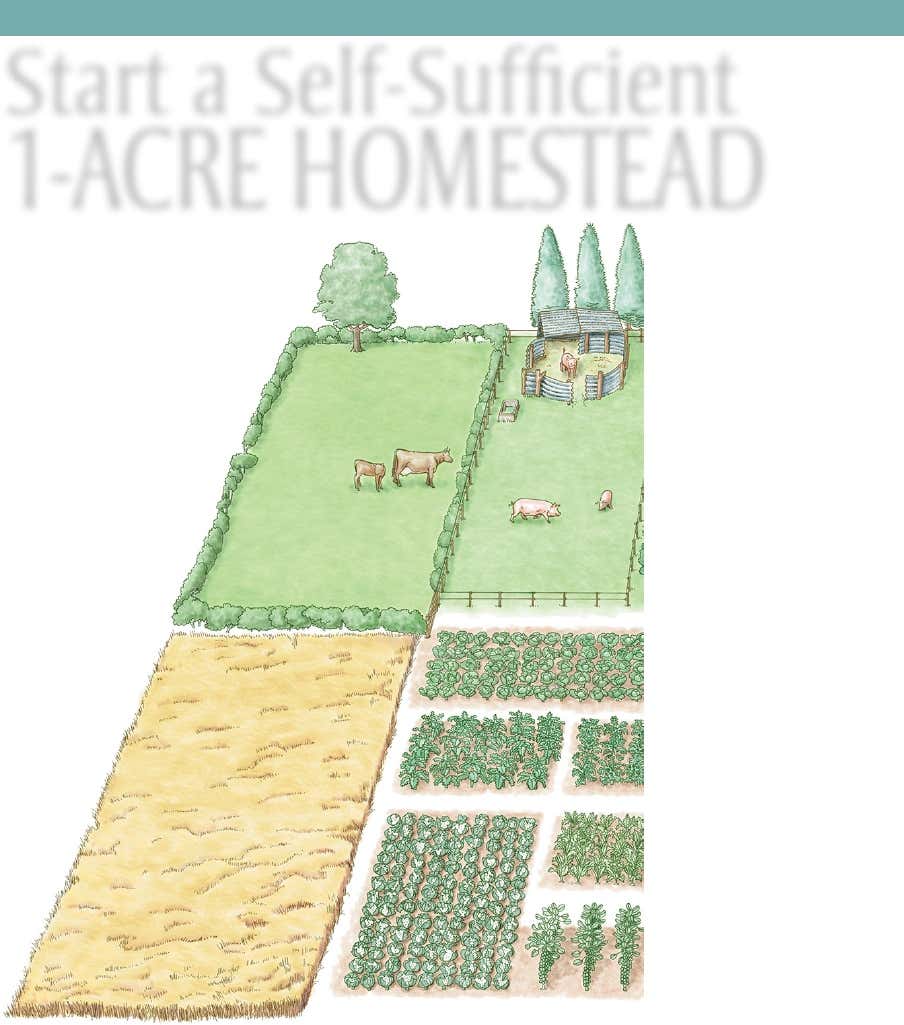
pigs and poultry get their share of the milk byproducts, es-pecially whey, they likely will be healthy, too. If your gardengets plenty of cow manure, your soil fertility will continuouslyincrease, along with your yields.On the other hand, the food that you buy in for this familycow will cost you hundreds of dollars each year. Compared with how much money you would spend on dairy productseach year, the fresh milk supply from the cow plus the increasedvalue of the eggs, poultry and pig meat that you will get, along with your ever-growing soil fertility, will quickly make a familycow a worthwhile investment. But a serious counter-consider-ation is that you will have to take on the responsibility of milk-ing a cow. Milking a cow doesn’t take very long — perhaps eightminutes — and it’s very pleasant if you know how to do it and ifshe is a quiet, docile cow — but you will have to do it. Buyinga dairy cow is a very important step, and you shouldn’t do itunless you do not intend to go away very much, or unless youcan make arrangements for somebody else to take over yourmilking duties while you’re gone. So let’s plan our 1-acre farmon the assumption that we are going to keep a dairy cow.
Your 1-acrehomestead can bedivided into landfor raising livestockand a garden forraising fruits andvegetables, plussome grain andforage crops.
Peas Runner (pole) beans French beans Broad beansPotatoesSpinachLettuceParsnipsCeleryLeeksOnionsHerbsGrassColdframesCurrantsCompostpilesCowshedGreenhouseToolshedFruit trees Mobile chicken coop Beehives Beets Fodder beets Rhubarb Raspberries
DORLING KINDERSLEY
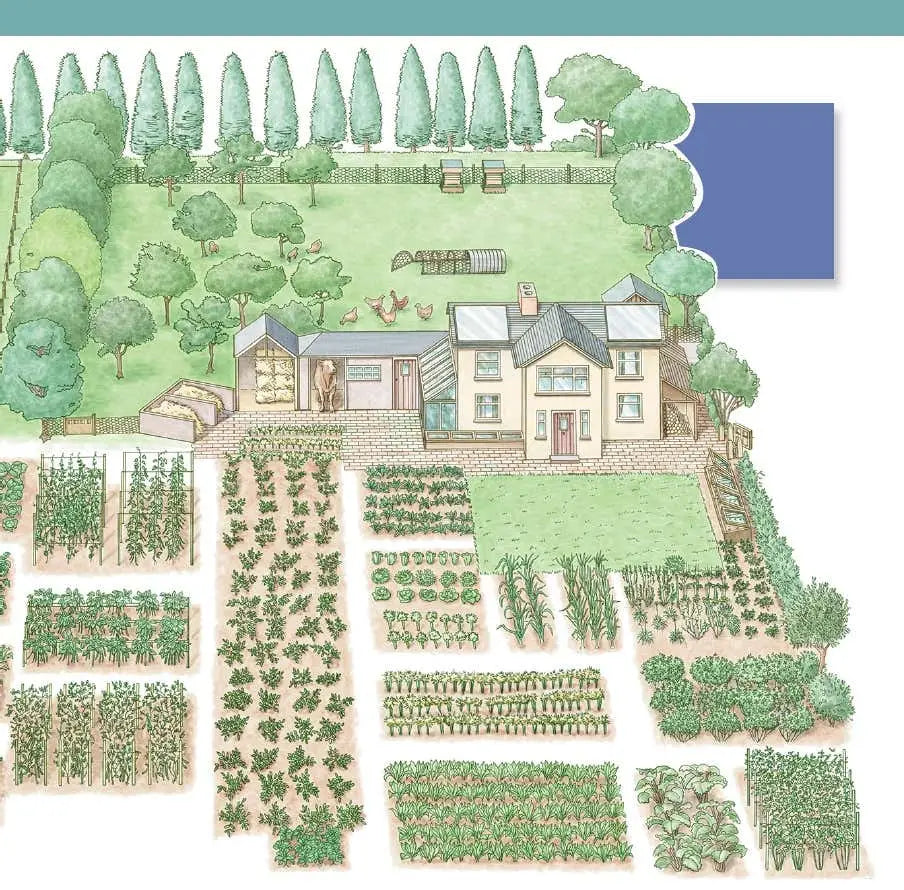
1-Acre Farm With a Family Cow
Half of your land would be put down to grass, leaving half anacre arable (not allowing for the land on which the house andother buildings stand). The grass half could remain permanent pasture and never be plowed up at all, or you could plan crop rotations by plowing it up, say, every four years. If you do the latter, it is best done in strips of a quarter of the half-acre so that each year you ’replanting a grass, clover and herb mix-ture on an eighth of your acre of land. This crop rotation will result in some freshly sown pasture every ear, some2-year-old field, some 3-year-old field and some 4-year-old field, resulting inmore productive land.
Grazing Management
At the first sign the grass patch is suffering from overgraz-ing, take the cow away. The point of strip grazing (also calledintensive rotational grazing) is that grass grows better andproduces more if it is allowed to grow for as long as possiblebefore being grazed or cut all the way down, and then allowedto rest again. In such intensive husbandry as we are envisagingfor this self-sufficient homestead, careful grazing management will be essential.Tether-grazing on such a small area may work better than using electric fencing. A little Jersey cow quickly gets used tobeing tethered and this was, indeed, the system that the breed was developed for on the island of Jersey (where they were first bred). I so unequivocally recommend a Jersey cow to the 1-acrefarmer because I am convinced that, for this purpose, she is without any peer. Your half-acre of grass, when established, should provide your cow with nearly all the food she needs forthe summer months. You are unlikely to get any hay from the half-acre as well, but if the grass grows faster than the cowcan eat it, then you could cut some ofit for hay.
Intensive Gardening
The remaining half of your home-stead—the arable half—would be farmed as a highly intensive garden. It would be divided, ideally, into fourplots, around which all the annual crops that you want to grow follow each other in a strict crop rotation. An ideal crop rotation might go something like this:—
Grass (for four years)
—
Plot 1: Potatoes
—
Plot 2: Legumes (pea and bean family)
—
Plot 3: Brassicas (cabbage family)
—
Plot 4: Root vegetables (carrots, beets, and so on)
—
Grass again (for four years)
Good crop rotations with careful grazingmanagement will give you rich soil.
A dairy cow can provide butter, cream, milk, yogurt and cheese, plus lots of manure to build soil fertility.
Get creative and make your own chicken coop: This ark can bemade out of used fertilizer bags for nearly nothing.
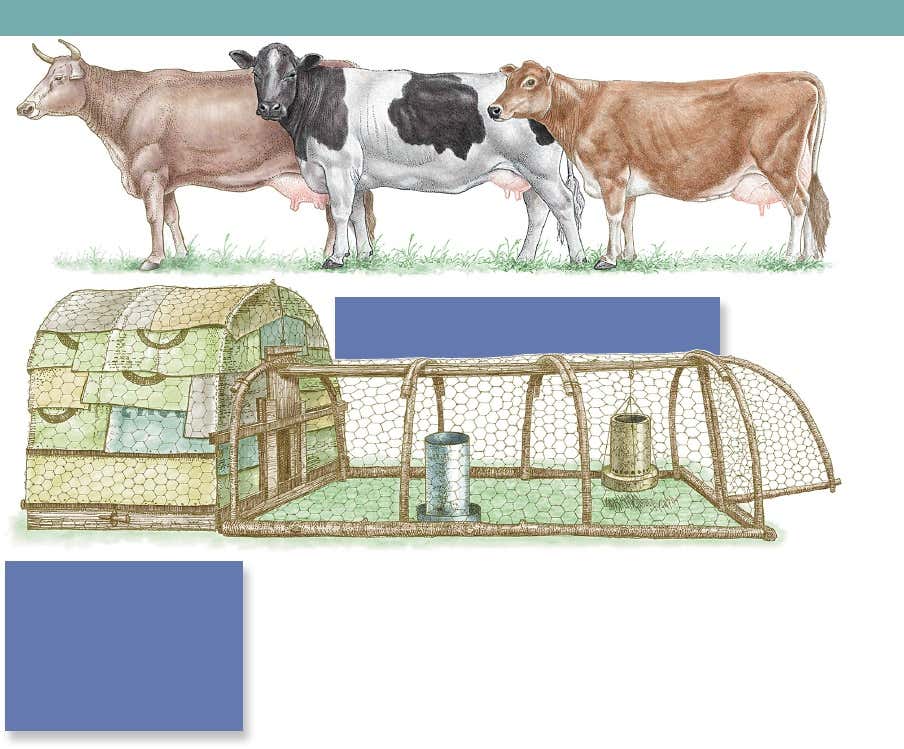
Consider the advantages of this kind of crop rotation. Aquarter of your arable land will be a newly plowed-up, 4-year-old field every year, with intensely fertile soil because of thestored-up fertility of all the grass, clover and herbs that have just been plowed-in to rot with four summers’ worth of cowmanure. Because your cow will be in-wintered, on bought-in hay, and treading and dunging on bought-in straw, you will have an enormous quantity ofmarvelous muck and cow manure toput on your arable land. All of thecrop residues that you cannot con-sume will help feed the cow, pigs orpoultry, and I would be surprised if,after following this crop rotation andgrazing management plan for a fewyears, you didn’t find that your acreof land had increased enormously insoil fertility, and that it was produc-ing more food for humans than many a 10-acre farm run onordinary commercial lines.
Half-Acre Crop Rotation
Some might complain that by having half your acre downto grass, you confine your gardening activities to a merehalf-acre. But actually, half an acre is quite a lot, and ifyou garden it well, it will grow more food for you thanif you were to “scratch” over a whole acre. Being undergrass (and grazed and dunged) for half of its life will enor-mously increase the half-acre’s soil fertility. I think you willactually grow more vegetables on this plot than you wouldon a whole acre if you had no cow or grass break.
Tips for the Self-SufficientHomestead
A
dairy cow
will not be able to stay outdoorsall year. She would horribly overgraze such asmall acreage. She should spend most ofthe winter indoors, only being turned out during the daytimein dry weather to get a little exercise and fresh air. Cows donot really benefit from being out in winter weather. Your cow would be, for the most part, better if kept inside where she would make lovely manure while feeding on the crops you grewfor her in the garden. In the summer you would let her out,night and day, for as long as you find the pasture is not beingovergrazed. You would probably findthat your cow did not need hay at allduring the summer, but she wouldbe entirely dependent on it through-out the winter, and you could planon having to buy her at least a ton. Ifyou wanted to rear her yearly calf un-til he reached some value, you wouldlikely need a further half-ton of hay. Ihave kept my cow on deep litter: Thelayer of straw gets turned into goodmanure, and I add more clean straw every day. I have milked acow this way for years, and the perfect milk made good butterand cheese, and stored well. Although more labor-intensive,you could keep your cow on a concrete floor instead (insulatedif possible), and give her a good bed of straw every day. You
Heavily manured, intenselyplanted garden beds willproduce more per acrethan most larger farms.
Chickens for eggs, meat and pest control are the top livestock choice on most homesteads.
You can grow your own wheatand dry it on simple tripodsmade from poles.
D O R L I N G K I N D E R S L E Y ( 4 )
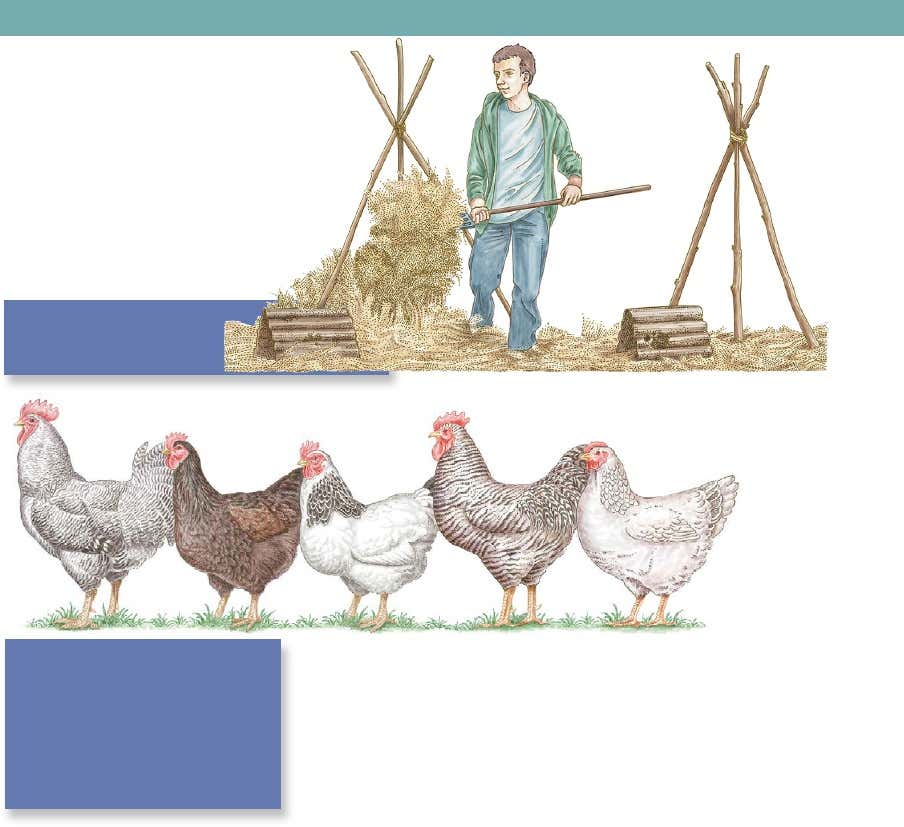
would remove the soiled straw daily, and carefully pile it into amuck heap that would be your fount of fertility for everythingon your acre.
Pigs
would have to be confined in a house for at least partof the year (and you would need to provide straw for them),because, on a 1-acre farm, you are unlikely to have enoughfresh land to keep them healthy. The best option would be amovable house with a strong movable fence outside it, but youcould have a permanent pigpen instead.The pigs would have a lot of outdoor work to do: They would spend part oftheir time plowing up your eighth of anacre of grassland, and they could run overyour cultivated land after you have har-vested your crops. They could only dothis if you had time to let them do it, assometimes you would be in too much of ahurry to get the next crop in. As for food,you would have to buy in some wheat,barley or corn. This, supplemented with the skim milk and wheyyou would have from your dairy cow, plus a share of the gardenproduce and such specially grown fodder crops as you couldspare the land for, would keep them excellently.If you could find a neighbor who would let you use a boar, Irecommend that you keep a sow and breed her. She could giveyou 20 piglets a year, two or three of which you could keep tofatten for your bacon and ham supply. The rest you could sellas weanlings (piglets eight to 12 weeks old), and they would prob-ably bring in enough money topay for the food you had to buyfor all your other livestock. If youcould not get the service of a boar,you could always buy weanlingsyourself—just enough for yourown use—and fatten them.
Poultry
could be kept in a per-manent house in one corner ofyour garden, or, preferably, inmobile coops on the land, so theycould be moved over the grass-land and improve soil fertility with their scratching and dung-ing. I would not recommendkeeping very many birds, as just a dozen hens should give youenough eggs for a small family with a few to occasionally sellor give away in summertime. You would have to buy a littlegrain for them, and in the winter some protein supplement,unless you could grow enough beans. You could try growingsunflowers, buckwheat or other food especially for them.
Goats
, if kept instead of a dairy cow (or in addition to),could be managed in much the same way, however you would not have as much whey and skimmilk to rear pigs and poultry on, andyou would not build up the fertility ofyour land as quickly as you could witha cow. You would only get a fractionof the manure from goats, but on theother hand you would not have to buynearly as much hay and straw—perhapsnot any. For a farmer wanting to have acompletely self-sufficient homestead on1 acre, dairy goats are a good option.
Crops
would be all of the ordinary garden crops (fruitsand vegetables), plus as much land as you could spare forfodder crops for animals. Bear in mind that practically anygarden crop that you grew for yourself would be good forthe animals too, so any surplus crops would go to them. You would not need a compost pile—your animals could be yourcompost pile.Half an acre, farmed as a garden with wheat grown inthe other half-acre, is worth a tryif you kept no animals at all, ormaybe only some poultry. You would then practice a crop ro-tation as described above, butsubstitute wheat for the grassand clover field. If you are avegetarian, this may be quite agood solution. But you couldnot hope to increase the soil fer-tility, and therefore the produc-tiveness, of your land as much as with animals.
Omnivorous pigs will eat almost anything, and can convert your surplus crops into delicious meat and fertile compost.
This article is an excerpt from
TheSelf-Sufficient Life and How to LiveIt
, written by the late John Seymourand first published by DorlingKindersley in Britain in 1976. Thebook has become a treasured classicfor back-to-the-landers and is nowavailable in a beautifully illustrated400-page edition.
Just a dozen hens will lay enough eggsfor you to eat, and afew extra to sell.
D O R L I N G K I N D E R S L E Y
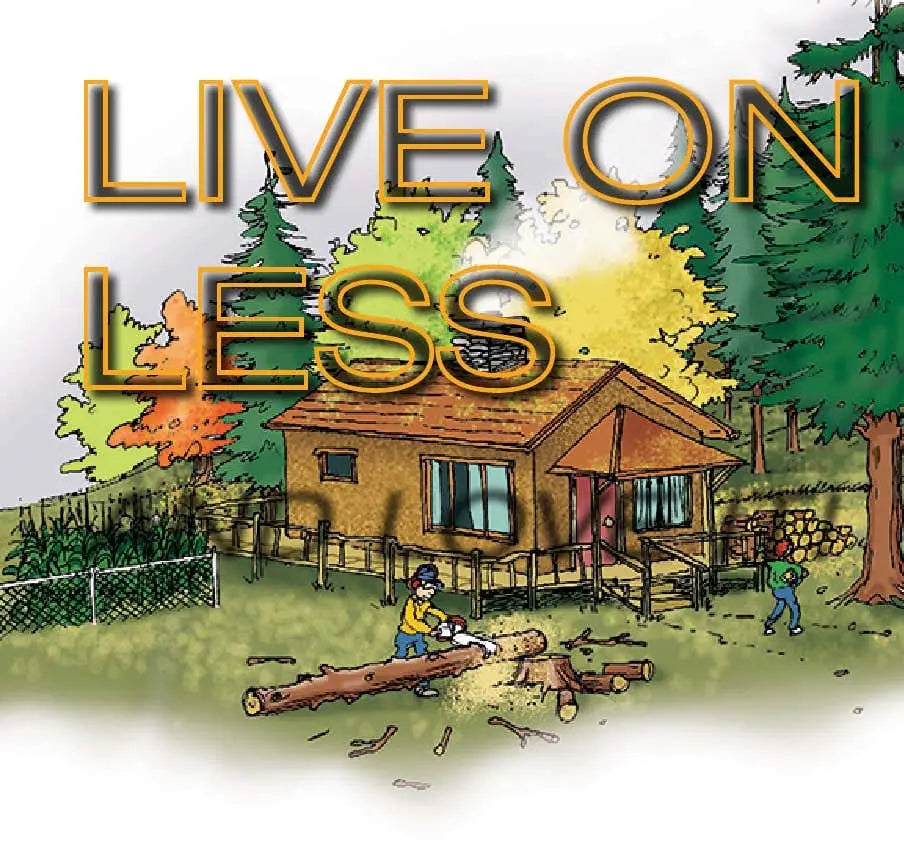
On paper, my wifeand I are poor.How poor? In2005 we made $4,303.84 com-bined; in 2004 we made half that. We’re in such a low tax bracket that I havetrouble convincing the government of ourtax return’s accuracy; they simply can’t be-lieve Americans can live on that kind ofmoney. Yet in many ways, we’re better off thana Wall Street banker: We’ve saved enoughmoney to buy land without a mortgage, we have no credit cards or monthly bills, I work 20 flexible hours a week from home,and my daughter has two stay-at-homeparents. Simply put, we never want foranything, and we have a lot of fun. We’ve arrived where we are nowthrough a decade of daily financial deci-sions. Because we didn’t want to spend ourtime earning money at jobs we didn’t like, we instead focused on how to stretchour money. We found that by con-trolling our day-to-day expenses, wecould save a lot of money withoutsacrificing our quality of life. Neithermy wife nor I will everbe confused for financial wizards;there’s nothing we’ve done that you can’tdo if you’re serious about saving money.Here are 75 money-saving tips to consider,drawn from our own experiences. Find what works for you and enjoy living on less!
GOOD CHEAP FOOD
1. Buy raw ingredients
instead of pre-packaged foods. If you don’t know how tocook, learn. You’ll save on food bills, andyour body will thank you for it in the longrun.
2. Buy in bulk
from a local health foodstore, or place bulk orders directly withmail-order companies. If you can’t meettheir minimum order size, go in on an or-der with another family, or organize a largerfood buying club.
3. Avoid the middleman
and buy directlyfrom farmers.
Look for farm stands, com-munity supported agriculture programsand farmers markets.
4. Eat fruits and vegetables in season
, when they are least expensive. (Once, wefound organic watermelon for three centsa pound!) Stock up when they’re cheapand freeze or can any excess for later use.
5. Keep up with what’s in your refriger-ator
and make sure nothing spoils. Oncea week, make soup or casseroles to use upvegetables and other leftovers.
6. Calculate the price of food perpound
when you visit supermarkets.Doing the math will help you spot gooddeals.
7. Don’t overeat.
When you do, you’reflushing money down the drain.
HOW TO AVOID RENT
8. Find a live-in elder care position
andhelp someone stay out of a nursing home.There’s always someone desperate for reli-able help, and often there are no qualifica-tions needed other than compassion.
9. Help renovate a house
in exchangefor lodging.
This is how we came into ourcurrent home.
10. For short-term stays, become ahousesitter or pet sitter.11. For long-term stays, become a care-taker.
A good place to find such caretak-ing jobs is
www.caretaker.org
If you live in a forested area, cutyour energy costs by heatingwith wood. And wherever youlive, never skimp on insulation—you’ll save money and energy.Stock up on produce when it’s inseason and at its cheapest, thencan or freeze it for later use.
FIND AND BUILD YOUR NEST
12. Look beyond realtors’ listings
tofind cheap property. Try local penny pa-pers.
13. Don’t be afraid to ask.
If you see apiece of land you like, find the owner andask if it’s for sale. It might be cheaper thanyou think.
14. Salvage materials for your newhome.
There are lots of possible sources:Look for someone who’s renovating a houseand might let you cart away old materials;check the yellow pages for used buildingmaterials; or look for online groups, suchas Freecycle, where people trade all kinds ofunwanted items.
15. Never skimp on insulation or good windows.
Build your home tight enough,and it will cost much less to heat. You mayeven be able to get away with a woodstoveor other supplemental heating and avoidthe cost of buying and running a centralheating system.
16. Barter for services with carpenters.
Some communities have organized timebanks, to make bartering these kinds ofservices easier. You can learn more aboutthem at
www.timebanks.org
.7. Buy into a piece of land with an-other family.
Be sure to check local zon-ing ordinances to be sure you can legallysubdivide a property before you buy it.
18. Build with natural materialsfound on-site.
If you have wood, theequipment to mill it yourself is rela-tively inexpensive, compared to buyinglumber. (You can resell the sawmill afteryou’re done with it.) Building with stoneor straw bales and using clay for plastersare other relatively inexpensive naturalbuilding options.
KEEP HOME UPKEEP COSTS DOWN
19. Close off unused rooms
to save onheat and air conditioning.
20. Be efficient with your appliances.
Have a big baking night when you’re go-ing to use the oven. Let your woodstovealso be your dryer and water heater.
21. Take advantage of natural weath-er patterns to heat and cool yourhouse.
In the summer, open the win-dows at night and close them again bynoon.
22. Place your refrigerator in thecoldest part of the house
so it requiresless energy to keep the temperature low.
23. Wash your clothes in cold water.
It’sthe friction that does most of the cleaning,not the heat.
24. Switch off your water heater
whenyou’re not going to use it for extended pe-riods of time.
25. Buy energy-efficient light bulbs.
The savings on your electric bills add upfast.
26. Unplug any unused electric items with lights, clocks or timers.
They usean amazing amount of power just sittingthere. You can plug multiple items into one
Make a habit of eating at home: It’s almost always cheaper, healthier and better-tastingthan eating at restaurants or fast food joints.

power strip to make shutting them all offfaster.
CREATIVE TRANSPORTATION
27. Carpool with friends or co-workers.
Some cities maintain online listings to helppeople connect with other carpoolers.
28. Ask if your city has a carshare pro-gram
or start one with people you trust.
29. Convert a diesel car to run on used vegetable oil.
You’ll pay once for the con-version or kit, but after that all your fuelcan be free. All you have to do is find a res-taurant that wants to dispose of their usedoil and will let you cart it away.
30. Keep track of your gas mileage
andlook for ways to improve it—keep yourtires properly inflated and don’t speed.
31. Do as many errands as possible with each car trip
around town insteadof making multiple trips. You’ll save a lotof gas.
32. Book any airplane trips well inadvance
to get the lowest possible fare.Then show up early and offer to bebumped in exchange for free tickets if aplane is overbooked.
WHEN YOU CAN’T AVOID SHOPPING
33. Don’t go into stores unless youneed something.
Always carry a shop-ping list. Remember, stores are designedto get you to buy things you didn’tknow you needed.
34. Hit end-of-season sales
for as manyitems as possible, from kayaks to gar-dening supplies.
35. Before you shop, try borrowing
theitems you need from family or friends.Check out local Freecycle groups to findout what people are giving away. Set upborrowing co-ops for tools.
36. Try to find it used
before you buynew. You can find a wide variety of itemsonline, in the classifieds or penny papers,and at garage sales, estate sales and thriftstores.
37. When buying new, choose high-quality, durable items.
It’s often cheaper tospend more upfront if you won’t have to re-place the item in the near future.
38. Instead of shopping, scavenge.
Watchthe curbs at the end of the semester in a col-lege town. If you live near a high school, trytalking to the janitor the last day of school when they’re cleaning out the lockers.
GET SOME CLOTHES ON!
Buy clothing used whenever possible.
You may have good luck finding clothesat garage sales, or find a wider selection atthrift stores, consignment shops and oneBay.
40. Have a clothing exchange party
totrade unwanted clothing with friends.
41. Try sewing.
Look for cheap materialin thrift stores, or try reincarnating youroutfits into something new.
42. Watch the clearance racks.
It’s al- ways amazing how much stores are willingto mark down unsold clothing.
FOR YOUR HEALTH
43. Ask a doctor or dentist if they havesliding-scale fees.44. Look for free or low-cost clinics
and/or medical schools for treatment
.
(But be warned, sometimes you get what you payfor. I have a couple of bad fillings from anew dentist.)
45. Do preventive maintenance on yourbody.
Exercise and eat well. Try yoga to re-duce stress. Quit smoking.
46. Campaign for a national healthcare system!
CUTTING EDUCATION COSTS
self
sufficiency
If you build your own home,take full advantage of naturalmaterials already on theproperty, such as timber,sand or clay.
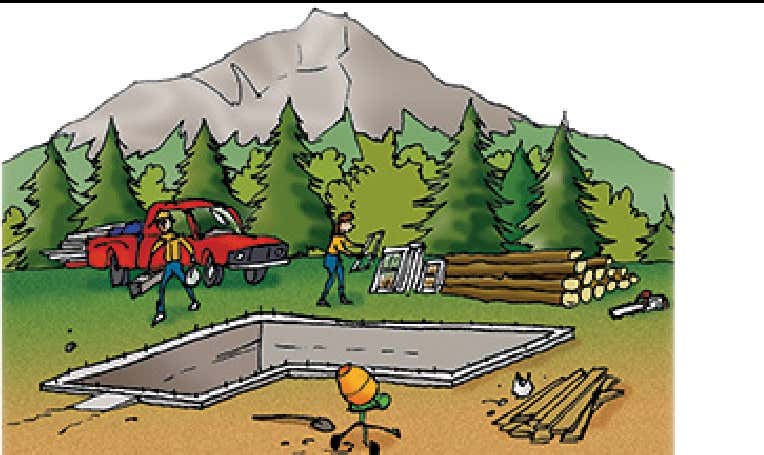
47. For the college bound, take somegeneral education classes at a state schoolor community college where the tuitionis low
, even if you plan to take most ofyour classes at a more expensive college. Just check carefully with your school ofchoice to make sure the classes will transfer.
48. Attend an in-state college.
Establishresidency for a year or two beforehand,if need be. The money saved can be well worth the time it takes to establish residency.
49. Buy your college books used online.
Don’t give in to the monopoly of the col-lege bookstore!
50. Watch for unique scholarship op-portunities
, including those that involveresources other than cash. (I once receiveda case of organic macaroni and cheese formaking the dean’s list.)
51. Audit classes
that you only want forthe learning, not the credit.
52. For lessons, try bartering.
For ex-ample, my wife is planning to do somephotography in exchange for dance lessons.
CHEAP ENTERTAINMENT
53. Discontinue your Internet serviceand utilize a wireless “hotspot”
whereyou can connect to the Internet for free.Even the smallest towns tend to have atleast one.
54. Rediscover the radical notion of thelibrary.
Imagine Internet access and thou-sands of books, CDs and DVDs for free!
55. Volunteer to usher
for concerts, playsand other events. (I haven’t paid for a playin years.)
56. Find low-cost fun in your local pa-per.
Take full advantage of free concerts,events and movies.
57. When at a concert or movie, avoidbuying anything to eat or drink.
Someplaces even let you bring your own snacks.
58. Take turns entertaining with friends
holding parties, potlucks or music nights.
59. Occasionally, go ahead and spendthe money.
Saving money’s like going ona diet: If you try to starve yourself, you’llend up consuming more in the long-run. Ifthere’s a form of entertainment you value,that’s a good place to consider splurging.
SEE THE WORLD FOR LESS
60. Volunteer
for organiza-tions such as Willing Workers onOrganic Farms (WWOOF) thatprovide food and lodging in ex-change for a reasonable amount ofdaily work.
61. Trade your home
withfriends around the country andenjoy free lodging in a new loca-tion.
62. Go camping, or rent a cab-in.
Don’t overlook state parks andnational forests, they’re often lessexpensive and less crowded thannational parks.
63. Try a local vacation.
Chancesare, there’s something great to see within a 100-mile radius of whereyou live.
64. Ask hotels about discounted dis-tressed-traveler rates,
especially if youhadn’t planned to stop but must because ofinclement weather.
65. There’s no law against haggling witha hotel on the room rate!66. Make your vacations pay for you
bycombining them with work. I once volun-teered for my school to check out an in-novative learning program in Vermont andgot to stay in a bed and breakfast with my wife for free.
67. Buy food at local supermarkets when traveling.
It’s much cheaper thaneating at restaurants.
68. wChoose a vehicle with fold-downseats
if you’re renting a car or truck. Finda safe place to sleep for the night, and youhave instant, snug lodging.
HAPPY FAMILIES FOR CHEAP
69. Definitely choose used clothes forbabies.
They’re so cute, they don’t need tobe stylish.
70. Trade babysitting time
with othercouples and have rotating playgroups withother families.
71. During the holidays, draw namesfor gift giving
with groups of family orfriends rather than buying a gift for ev-erybody. A fun variation or addition tothis is the white elephant holiday party, where everyone brings unwanted itemsand other joke gifts.
72. Invoke a gift giving spending cap.73. Give homemade gift certificates
for ahome-cooked dinner, massage or babysit-ting time.
74. Donate to a good cause
that a friendor family member supports instead ofbuying a gift they don’t need. Not only doyou support a worthwhile organization,but you’ll save on sales tax and transporta-tion costs.
75. Swallow your pride; accept your fam-ily’s help every now and then.
It’ll makethem feel good.These suggestions are just a startingplace. You’ll find lots of new ways to savethat work best for you. Make a game of it ifyou can, and keep it fun. After all, it’s onlymoney. Happy penny pinching!
self
sufficiency
Rediscover the radical notion of a public library:Get books, music and movies for free!The author and his family livehappily and frugally in Maine.
F R A N C E S I D L E B R O O K






Leave a comment